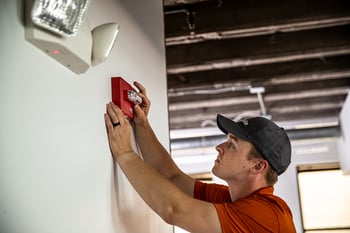
When it comes to fire safety, one of the most important things you can do is make sure you have working smoke detectors and fire alarms. With this one crucial step, you’re ensuring that if a fire happens, you’re going to know about it.
Fortunately, it’s fairly simple to keep your smoke detectors and fire alarms working correctly. In this guide, we’ll walk you through everything you need to know about types of detectors and alarms, maintenance, placement and more, so you can keep your family or business as safe as possible.
Types of Alarms
Smoke detectors and fire alarms are terms often used synonymously, but there is an important difference. A smoke detector works as simply a sensor, and a fire alarm acts on it – it sounds an alarm. Nearly all smoke detectors also act as fire alarms, but if purchasing a new one, you’ll want to be sure to check the package to make sure.
Fire alarms can either be electrical or battery powered. Electrical ones plug directly into the wiring (often with backup batteries also), while battery powered ones run on batteries only.
Ideally, the alarms will be interconnected – if one goes off, they’ll all go off. They can be interconnected via hardwiring, or wirelessly. You may have to purchase within the same brand or make to ensure that they can communicate effectively in case of a fire.
Another key difference is in the type of detector itself. There are two main types of detectors: ionization and photoelectric. Ionization alarms are better at detecting fires with flames, and photoelectric are better at detecting smoldering or low-flame fires. These days, many alarms offer both types of detectors.
Finally, check to see if your fire alarms include a carbon monoxide detector. If not, you’ll want to make sure to purchase this type of detector as well.
Where to Place Them
Another important aspect to making sure your fire alarms will work when you need them to is proper placement.
Generally, fire alarms should be placed:
- High on the wall, no more than 12 inches from the ceiling
- 10 feet away from cooking appliances (to prevent false alarms)
- 3 feet away from bathrooms with tubs and showers (to prevent false alarms from steam)
If you have a pitched roof or high ceilings, check with your local fire department for specific guidance on placement.
Fire alarms need to go on every floor of a business or of your home and in every sleeping area or bedroom of a home. That way, you’ll definitely hear them, even if they go off in the middle of the night.
Maintenance Timeline
Of course, even if your fire detectors are placed in all the right places and connected appropriately, you won’t hear them go off if they aren’t working in the first place. For this reason, following proper maintenance and replacement timelines is crucial.
All smoke detectors and fire alarms should be tested at least once a month by pushing the test button on each alarm to ensure it’s working properly. Fresh batteries should be put into each alarm at least once a year. Among fires in which smoke alarms were present but didn't function correctly, 46% of the alarms had missing or disconnected batteries, according to the National Fire Protection Association.
For businesses, the NFPA 72 – National Fire Alarm and Signaling Code – addresses all inspection, testing, and maintenance for smoke detectors. All smoke detectors need to be inspected semi-annually, functionally tested annually, sensitivity tested 1 year after installation (then every other year – eventually increasing to every 5 years if sensitivity remains in range), and, finally, maintained per manufacturer’s instructions. All of this can be done by an experienced life safety technician.
For more information on smoke detector maintenance, we recommend this article from the NFPA.
Final Word
Working smoke detectors and fire alarms can save your life if a fire happens in your business or home. They’re too important to ignore – especially when keeping them functional is so simple.
Overwhelmed with fire safety options like smoke detectors and fire alarms? CertaSite can help simplify the process. Check out our website for more helpful blogs, resources and more, or to book a private consultation for your business with our highly-trained fire and life safety experts.

